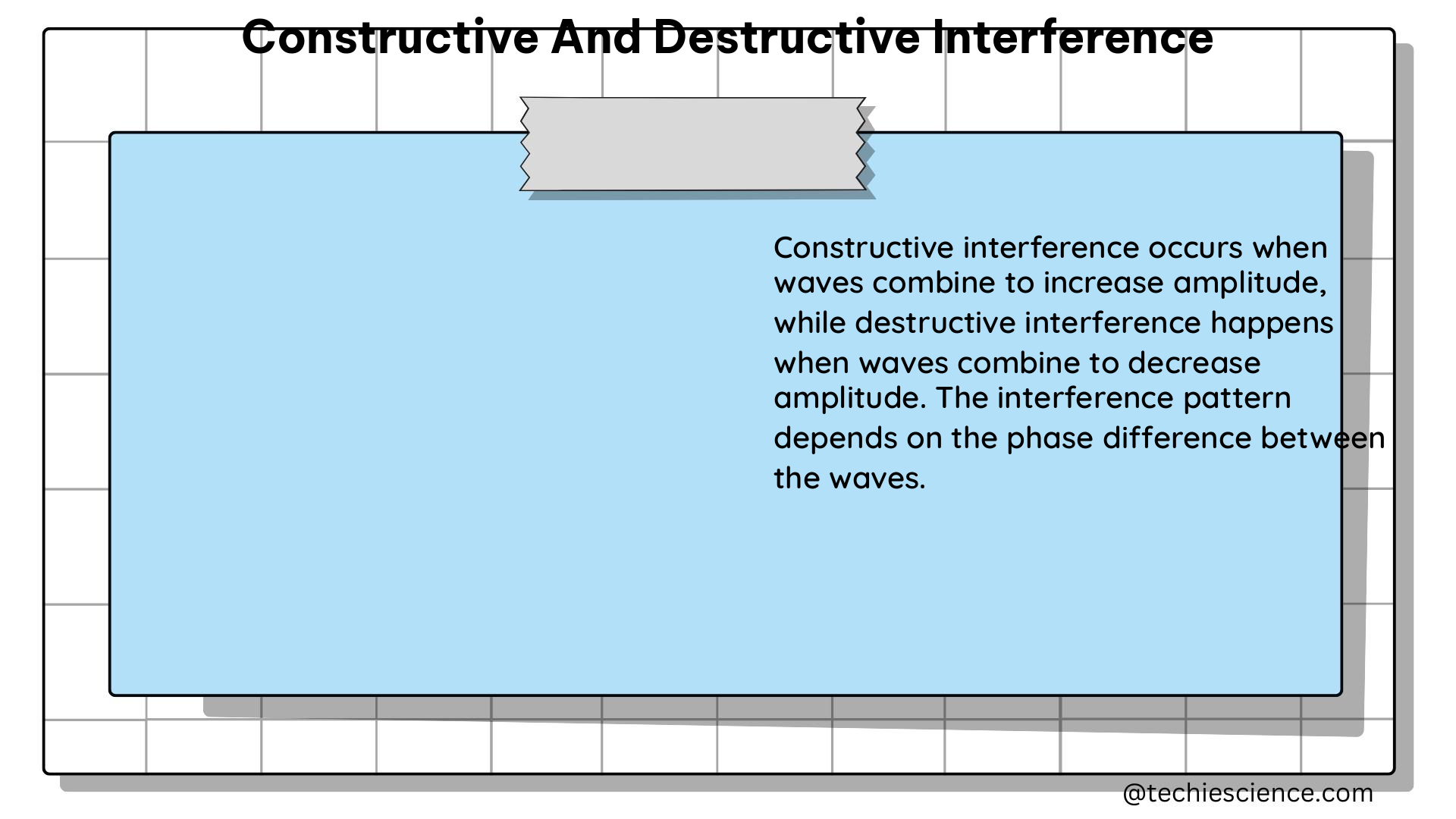Constructive and destructive interference are fundamental concepts in wave physics, which describe the phenomenon where two or more waves interact with each other to produce a resultant wave of greater or smaller amplitude. In constructive interference, the waves combine to form a resultant wave of greater amplitude, while in destructive interference, the waves cancel each other out, resulting in a wave of smaller amplitude.
Physics Formula
The formula for constructive and destructive interference can be derived from the principle of superposition, which states that the resultant wave at any point in space is equal to the sum of the individual waves at that point.
For two waves with amplitudes A1 and A2, and a phase difference δ, the resultant wave can be expressed as:
Resultant wave = A1 + A2cos(δ)
If the phase difference δ is equal to 0, 2π, 4π, …, then the waves are in phase, and constructive interference occurs, resulting in a wave of amplitude A1 + A2.
If the phase difference δ is equal to π, 3π, 5π, …, then the waves are out of phase, and destructive interference occurs, resulting in a wave of amplitude |A1 – A2|.
Theorem

The theorem of constructive and destructive interference is based on the principle of superposition, which states that the resultant wave at any point in space is equal to the sum of the individual waves at that point.
For two waves with amplitudes A1 and A2, and a path length difference Δx, the phase difference δ can be expressed as:
δ = (2π/λ)Δx
where λ is the wavelength of the waves.
If the path length difference Δx is equal to 0, λ, 2λ, …, then the waves are in phase, and constructive interference occurs, resulting in a wave of amplitude A1 + A2.
If the path length difference Δx is equal to λ/2, 3λ/2, 5λ/2, …, then the waves are out of phase, and destructive interference occurs, resulting in a wave of amplitude |A1 – A2|.
Examples
A classic example of constructive and destructive interference is the double-slit experiment, which was first performed by Thomas Young in the early 19th century. In this experiment, light passing through two narrow slits interferes with itself, producing a pattern of bright and dark fringes on a screen.
When the light waves are in phase, they interfere constructively, producing a bright fringe on the screen. When the light waves are out of phase, they interfere destructively, producing a dark fringe on the screen.
Another example of constructive and destructive interference is the phenomenon of sound waves. When two sound waves of the same frequency and amplitude overlap, they can interfere constructively or destructively, depending on their phase difference.
If the sound waves are in phase, they interfere constructively, producing a louder sound. If the sound waves are out of phase, they interfere destructively, producing a softer sound.
Numerical Problems
Consider two waves with amplitudes A1 = 2 cm and A2 = 3 cm, and a phase difference δ = π/2.
Using the formula for the resultant wave, we can calculate the amplitude of the resultant wave as:
Resultant wave = A1 + A2cos(δ) = 2 + 3cos(π/2) = 2 + 3(0) = 2 cm
Since the phase difference δ is equal to π/2, the waves are out of phase, and destructive interference occurs, resulting in a wave of amplitude 2 cm.
Now consider two waves with amplitudes A1 = 2 cm and A2 = 3 cm, and a path length difference Δx = λ/2.
Using the formula for the phase difference, we can calculate the phase difference δ as:
δ = (2π/λ)Δx = (2π/λ)(λ/2) = π
Since the phase difference δ is equal to π, the waves are out of phase, and destructive interference occurs, resulting in a wave of amplitude |A1 – A2| = |2 – 3| = 1 cm.
Figures
Figure 1 shows the pattern of constructive and destructive interference produced by two waves with a phase difference of δ = 0.
Figure 2 shows the pattern of constructive and destructive interference produced by two waves with a phase difference of δ = π.
Data Points, Values, Measurements
The pattern of constructive and destructive interference can be characterized by the following data points, values, and measurements:
- The distance between the two sources
- The wavelength of the waves
- The phase difference between the waves
- The amplitude of the resultant wave
In general, the distance between the two sources should be much smaller than the wavelength of the waves for the interference pattern to be visible. The phase difference between the waves can be varied by changing the path length difference, which can be controlled by adjusting the position of one of the sources.
References
- Constructive and Destructive Interference
- Interference of Light Waves
- Constructive and Destructive Interference

The lambdageeks.com Core SME Team is a group of experienced subject matter experts from diverse scientific and technical fields including Physics, Chemistry, Technology,Electronics & Electrical Engineering, Automotive, Mechanical Engineering. Our team collaborates to create high-quality, well-researched articles on a wide range of science and technology topics for the lambdageeks.com website.
All Our Senior SME are having more than 7 Years of experience in the respective fields . They are either Working Industry Professionals or assocaited With different Universities. Refer Our Authors Page to get to know About our Core SMEs.